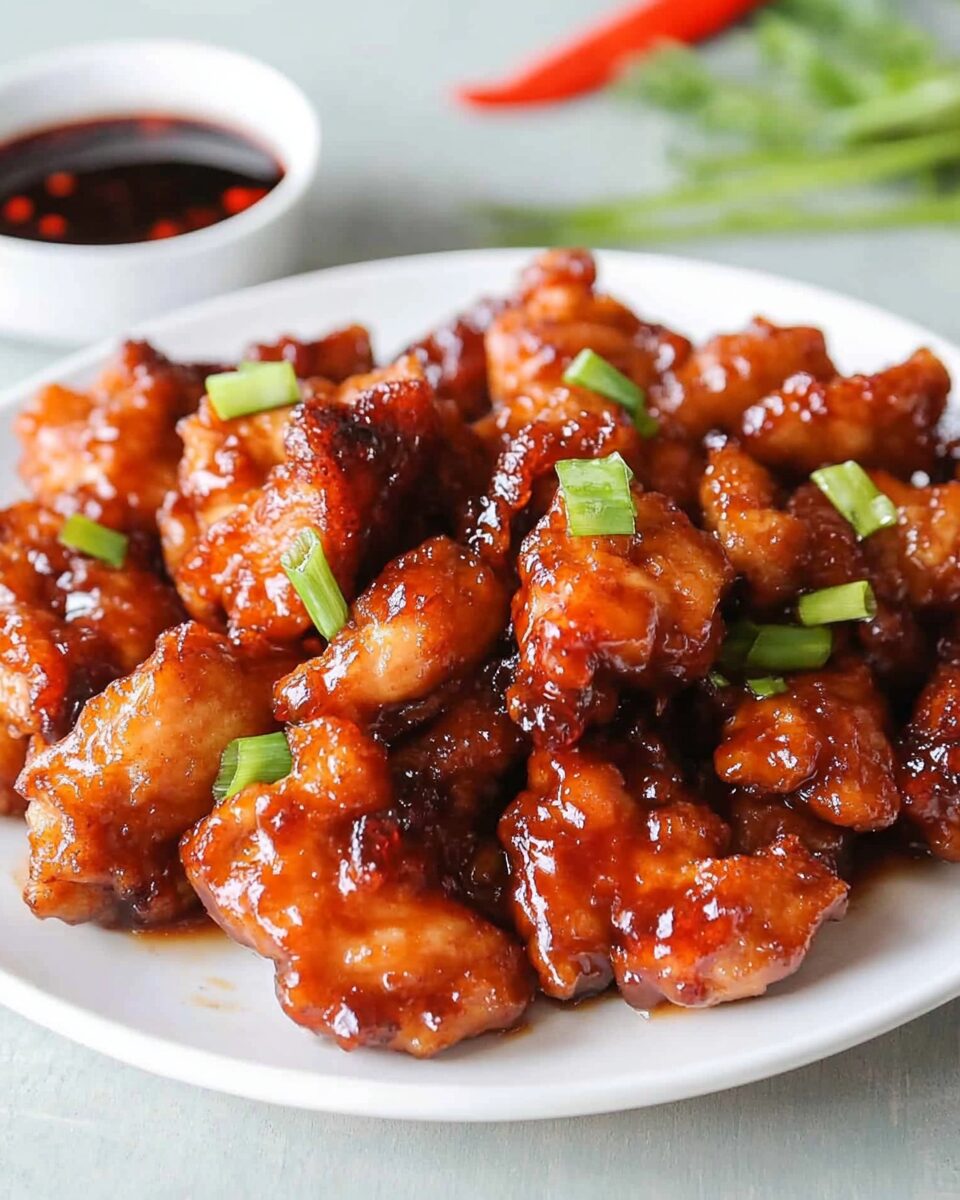Mongolian Chicken is a delightful Chinese-American dish featuring crispy fried chicken pieces tossed in a sticky, sweet, and savory sauce. Infused with ginger, garlic, and a hint of spice from red chili, this flavorful main course pairs wonderfully with steamed rice and vegetables. It’s a quick and easy recipe that can be prepared in about 25 minutes, making it perfect for a satisfying dinner.
FULL RECIPE:
Ingredients
- 1 lb (approximately 450g) skinless boneless chicken thighs
- ¼ cup cornstarch (or potato starch)
- ⅓ cup vegetable oil (or any neutral oil)
- 2 cloves garlic, minced
- 1 red chili pepper, sliced (optional)
- 5 slices fresh ginger
- 4 tablespoons hoisin sauce
- 2 tablespoons regular soy sauce
- 2 tablespoons brown sugar
- 2 teaspoons sesame oil
Cornstarch Slurry:
- 1 tablespoon cornstarch (or potato starch)
- ½ cup water
Optional Garnishes:
- 1 green onion, finely chopped
- Additional sliced red chili pepper
Directions
-
Prepare the Cornstarch Slurry: In a small bowl, mix 1 tablespoon of cornstarch with ½ cup of water until well combined. Set aside.
-
Dice the Chicken: Cut the chicken thighs into 1.5-inch pieces, yielding about 4-6 pieces per thigh. It’s advisable not to pat the chicken dry, as the moisture helps the cornstarch adhere better.
-
Coat the Chicken: Place the diced chicken into a large bowl. Add ¼ cup of cornstarch and toss until each piece is evenly coated.
-
Fry the Chicken: In a large pan, heat ⅓ cup of vegetable oil over medium-high heat. Once the oil is hot, fry the coated chicken pieces until they are golden brown and crispy, approximately 5-6 minutes on each side. Once cooked, remove the chicken and place it on a wire rack or a plate lined with paper towels to drain any excess oil.
-
Sauté Aromatics: In the same pan, remove any excess oil, leaving about 1-2 teaspoons. Add the minced garlic, sliced red chili pepper, and ginger slices. Sauté over medium heat until fragrant, which should take about 30 seconds.
-
Prepare the Sauce: Add the hoisin sauce, soy sauce, brown sugar, and sesame oil to the pan. Stir until the mixture is well combined and the sugar has dissolved.
-
Thicken the Sauce: Give the previously prepared cornstarch slurry a quick stir to recombine, then pour it into the pan. Stir continuously until the sauce thickens to your desired consistency.
-
Combine with Chicken: Return the fried chicken pieces to the pan. Toss them in the thickened sauce until they are thoroughly coated and heated through.
-
Serve: Transfer the Mongolian Chicken to a serving dish. Garnish with finely chopped green onions and additional sliced red chili pepper if desired. Serve hot alongside steamed rice and vegetables.
Nutritional Information
- Calories: Approximately 224 kcal per serving
- Protein: Approximately 20g
- Carbohydrates: Approximately 15g
- Fat: Approximately 9g
- Saturated Fat: Approximately 2g
- Cholesterol: Approximately 70mg
- Sodium: Approximately 800mg
- Fiber: Approximately 1g
- Sugar: Approximately 7g
Origins and History of Mongolian Chicken
Mongolian Chicken is a popular dish in Chinese-American cuisine that features crispy fried chicken tossed in a sweet, savory, and slightly spicy sauce. Despite its name, the dish does not originate from Mongolia. Instead, it is an adaptation of Mongolian Beef, a dish commonly found in American-Chinese restaurants. The name was likely chosen to evoke an exotic and appealing flavor profile rather than indicate an actual Mongolian origin.
The dish is heavily influenced by traditional Chinese cooking techniques, particularly those of northern China. However, it was popularized in Western countries, especially in the United States, where Asian-inspired flavors were adapted to suit a broader palate. Over the years, Mongolian Chicken has evolved to include different variations, incorporating additional vegetables and spices to enhance its taste.
Why Mongolian Chicken is a Favorite Dish
Mongolian Chicken is a well-loved dish for several reasons. First, it strikes the perfect balance between sweet and savory, thanks to its rich sauce made with soy sauce, hoisin sauce, brown sugar, garlic, and ginger. The combination of these ingredients creates a deep, umami-packed flavor that is both comforting and satisfying. Furthermore, Mongolian Chicken is relatively quick and easy to prepare, making it an excellent choice for weeknight dinners. The cooking process mainly involves frying the chicken, making the sauce, and combining the two—a simple yet rewarding technique that results in an incredibly flavorful dish.
Variations and Customization
One of the best aspects of Mongolian Chicken is its adaptability. While the classic version consists of crispy fried chicken tossed in sauce, several variations exist to suit different dietary preferences and taste preferences:
- Vegetable Additions: Many people like to include vegetables such as bell peppers, broccoli, or snow peas to add freshness and texture to the dish. These vegetables not only enhance the dish’s visual appeal but also contribute additional nutrients.
- Spicy Mongolian Chicken: Some variations include red pepper flakes, chili oil, or Szechuan peppercorns for added heat. This spicy twist can elevate the dish and appeal to those who enjoy bold flavors.
- Healthier Versions: Instead of deep-frying the chicken, some prefer to use a lighter approach by stir-frying or baking the chicken. Using lean chicken breast instead of chicken thighs can also make the dish lower in fat.
- Alternative Protein Options: While chicken is the main protein used in this dish, it can also be made with shrimp, tofu, or even beef. Each protein absorbs the sauce differently, creating unique textures and flavors.
Pairing Suggestions for Mongolian Chicken
Mongolian Chicken is best enjoyed with simple side dishes that complement its rich and bold flavors. Some great pairing options include:
- Steamed Rice: The neutral flavor of plain steamed rice helps balance the sweet and savory sauce of the dish. Jasmine rice or basmati rice are excellent choices.
- Fried Rice: A more indulgent option, fried rice adds an extra layer of flavor and texture to the meal. Garlic fried rice, egg fried rice, or vegetable fried rice all pair well with Mongolian Chicken.
- Noodles: Lo mein, chow mein, or stir-fried noodles are great alternatives to rice. The sauce coats the noodles beautifully, making for a delicious and complete meal.
- Vegetables: A side of stir-fried or steamed vegetables such as bok choy, green beans, or zucchini can add a fresh contrast to the richness of the chicken.
- Spring Rolls or Dumplings: As an appetizer, crispy spring rolls or dumplings complement Mongolian Chicken perfectly, adding variety to the meal.
Cultural Significance of Mongolian Chicken
The dish is part of a broader trend in American-Chinese cuisine, which includes dishes like General Tso’s Chicken, Orange Chicken, and Sweet and Sour Chicken. These dishes share a common theme of crispy protein coated in a flavorful sauce, making them incredibly appealing to Western palates. Mongolian Chicken stands out due to its distinct balance of flavors and the use of hoisin sauce, which adds depth and complexity.
Health Benefits of Mongolian Chicken
While Mongolian Chicken is considered a comfort food, it can also provide nutritional benefits when prepared with balance in mind. Some of its health benefits include:
- High-Quality Protein: Chicken is an excellent source of lean protein, which helps build and repair muscles while keeping you full and satisfied.
- Antioxidants and Anti-Inflammatory Properties: Ingredients like ginger and garlic have powerful health benefits. Ginger aids digestion and has anti-inflammatory properties, while garlic boosts the immune system.
- Customizable for Healthier Eating: By opting for healthier cooking methods such as baking or air-frying the chicken, reducing the amount of sugar in the sauce, or adding more vegetables, this dish can be made healthier without compromising its delicious flavor.
Common Mistakes to Avoid When Cooking Mongolian Chicken
Even though Mongolian Chicken is a relatively simple dish to prepare, a few common mistakes can impact the final result. Here are some tips to ensure success:
- Not Coating the Chicken Properly: Ensuring the chicken is evenly coated in cornstarch before frying is crucial for achieving a crispy texture.
- Overcrowding the Pan: When frying the chicken, it’s essential to fry in batches to maintain the oil temperature and ensure even crisping.
- Overcooking the Sauce: The sauce should be thickened just enough to coat the chicken. Overcooking it can lead to a sauce that is too thick or caramelized.
- Using the Wrong Type of Soy Sauce: Dark soy sauce can make the dish too salty or overpowering. Sticking to regular soy sauce helps balance the flavors.
- Skipping the Aromatics: Garlic and ginger are key to creating the dish’s signature taste. Skipping these ingredients can result in a sauce that lacks depth.
Conclusion
Mongolian Chicken is a beloved dish that combines crispy, flavorful chicken with a rich and savory sauce. Though it does not originate from Mongolia, its popularity in Chinese-American cuisine has made it a staple in many households and restaurants. Its versatility, ease of preparation, and bold taste make it an excellent choice for a satisfying meal. Whether you are cooking it for a quick weeknight meal or preparing it for a gathering, Mongolian Chicken is guaranteed to impress with its irresistible taste and deliciously sticky sauce. Give this recipe a try and enjoy a restaurant-quality meal from the comfort of your home!






